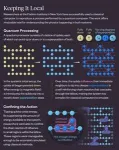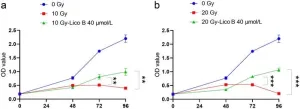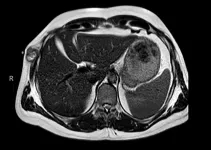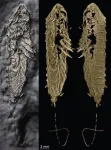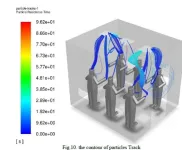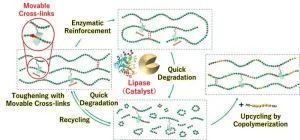(Press-News.org) Earlier this year, researchers at the Flatiron Institute’s Center for Computational Quantum Physics (CCQ) announced that they had successfully used a classical computer and sophisticated mathematical models to thoroughly outperform a quantum computer at a task that some thought only quantum computers could solve.
Now, those researchers have determined why they were able to trounce the quantum computer at its own game. Their answer, presented on October 29 in Physical Review Letters, reveals that the quantum problem they tackled — involving a particular two-dimensional quantum system of flipping magnets — displays a behavior known as confinement. This behavior had previously been seen in quantum condensed matter physics only in one-dimensional systems.
This unexpected finding is helping scientists better understand the line dividing the abilities of quantum and classical computers and provides a framework for testing new quantum simulations, says lead author Joseph Tindall, a research fellow at the CCQ.
“There is some boundary that separates what can be done with quantum computing and what can be done with classical computers,” he says. “At the moment, that boundary is incredibly blurry. I think our work helps clarify that boundary a bit more.”
By harnessing principles from quantum mechanics, quantum computers promise huge advantages in processing power and speed over classical computers. While classical computations are limited by the binary operations of ones and zeros, quantum computers can use qubits, which can represent both 0 and 1 simultaneously, to process information in a fundamentally different way.
Quantum technology is still in its infancy, though, and has yet to convincingly demonstrate its superiority over classical computers. As scientists work to figure out where quantum computers might have an edge, they’re coming up with complex problems that test the limits of classical and quantum computers.
The results of one recent test of quantum computers came out in June 2023, when IBM researchers published a paper in the journal Nature. Their paper detailed an experiment simulating a system with an array of tiny flipping magnets evolving over time. The researchers claimed that this simulation was only feasible with a quantum computer, not a classical one. After learning about the new paper through press coverage, Tindall decided to take up the challenge.
Tindall has been working with colleagues over the last several years to develop better algorithms and codes for solving complex quantum problems with classical computers. He applied these methods to IBM’s simulation, and in just two weeks he proved he could solve the problem with very little computing power — it could even be done on a smartphone.
“We didn’t really introduce any cutting-edge techniques,” Tindall says. “We brought a lot of ideas together in a concise and elegant way that made the problem solvable. It was a method that IBM had overlooked and was not easily implemented without well-written software and codes.”
Tindall and his colleagues published their findings in the journal PRX Quantum in January 2024, but Tindall didn’t stop there. Inspired by the simplicity of the results, he and his co-author Dries Sels of the Flatiron Institute and New York University set out to determine why this system could be so easily solved with a classical computer when, on the surface, it appeared to be a very complex problem.
“We started thinking about this question and noticed a number of similarities in the system’s behavior to something people had seen in one dimension called confinement,” Tindall says.
Confinement is a phenomenon that can arise under special circumstances in closed quantum systems and is analogous to the quark confinement known in particle physics. To understand confinement, let’s begin with some quantum basics. On quantum scales, an individual magnet can be oriented up or down, or it can be in a ‘superposition’ — a quantum state in which it points both up and down simultaneously. How up or down the magnet is affects how much energy it has when it’s in a magnetic field.
In the system’s initial setup, the magnets all pointed in the same direction. The system was then perturbed with a small magnetic field, making some of the magnets want to flip, which also encouraged neighboring magnets to flip. This behavior — where the magnets influence each other’s flipping — can lead to entanglement, a linking of the magnets’ superpositions. Over time, the increased entanglement of the system makes it hard for a classical computer to simulate.
However, in a closed system, there’s only so much energy to go around. In their closed system, Tindall and Sels showed that there was only enough energy to flip small, sparsely separated clusters of orientations, directly limiting the growth of entanglement. This energy-based limitation on entanglement is known as confinement, and it occurred as a completely natural consequence of the system’s two-dimensional geometry.
“In this system, the magnets won’t just suddenly scramble up; they will actually just oscillate around their initial state, even on very long timescales,” Tindall says. “It is quite interesting from a physics perspective because that means the system remains in a state which has a very specific structure to it and isn’t just completely disordered.”
Serendipitously, IBM had, in their initial test, set up a problem where the organization of the magnets in a closed two-dimensional array led to confinement. Tindall and Sels realized that since the confinement of the system reduced the amount of entanglement, it kept the problem simple enough to be described with classical methods. Using simulations and mathematical calculations, Tindall and Sels came up with a simple, accurate mathematical model that describes this behavior.
“One of the big open questions in quantum physics is understanding when entanglement grows rapidly and when it doesn’t,” Tindall says. “This experiment gives us a good understanding of an example where we don’t get large-scale entanglement due to the model used and the two-dimensional structure of the quantum processor.”
The results suggest that confinement itself could show up in a range of two-dimensional quantum systems. If it does, the mathematical model developed by Tindall and Sels offers an invaluable tool for understanding the physics happening in those systems. Additionally, the codes used in the paper can provide a benchmarking tool for experimental scientists to use as they develop new computer simulations for other quantum problems.
ABOUT THE FLATIRON INSTITUTE
The Flatiron Institute is the research division of the Simons Foundation. The institute's mission is to advance scientific research through computational methods, including data analysis, theory, modeling and simulation. The institute's Center for Computational Quantum Physics aims to develop the concepts, theories, algorithms and codes needed to solve the quantum many-body problem and to use the solutions to predict the behavior of materials and molecules of scientific and technological interest.
END
The surprising reason a classical computer beat a quantum computer at its own game
As the battle between quantum and classical computers rages, scientists are making unexpected discoveries about quantum systems
2024-10-29
ELSE PRESS RELEASES FROM THIS DATE:
Researchers Aim To Get Leg Up on Bone Repair with 3D-Printed Femur
2024-10-29
University of Texas at Dallas mechanical engineers have designed a 3D-printed femur that could help doctors prepare for surgeries to repair bones and develop treatments for bone tumors.
The engineers, who worked in collaboration with UT Southwestern Medical Center orthopedic surgeons, published their first study on the 3D-printed thigh bone online Aug. 5 in the Journal of Orthopaedic Research.
The study, which focused on the middle section of the bone, establishes 3D-printing parameters for a femur for use in biomechanical testing. Researchers said more studies will be needed before the technology could be available for widespread use.
To study and validate innovative surgical implants ...
Transforming patient care: study finds bedside interdisciplinary rounds boost satisfaction for patients and providers
2024-10-29
A study led by researchers at the University of Colorado Anschutz Medical Campus reveals patients and providers have more positive overall care experiences when the entire healthcare team is a part of bedside interdisciplinary rounds (BIDR).
The study published today in the Journal of General Internal Medicine.
The study found that BIDR, when the team meets at a patients’ bedside in the hospital to discuss care plans, helps build trust between patients and their healthcare providers and within healthcare teams by allowing everyone to observe and work together more closely.
“Traditional ...
Radioprotective effects of licochalcone B: DNA protection, cytokine inhibition, and antioxidant boost
2024-10-29
Background and objectives
Radiation injury poses a serious threat to human health, causing complex and multifaceted damage to cells and tissues. Such injury can be caused by various factors, including nuclear accidents, medical radiation therapy, and space travel. Currently, finding effective treatment methods and drugs to mitigate the harmful effects of radiation injury on the human body is a crucial research direction. This study aimed to explore the protective effects and mechanisms of Licochalcone ...
Complete response to encorafenib + binimetinib in BRAF V600E-mutant tumor
2024-10-29
“This case report highlights the importance of full tumor genotyping to identify potentially actionable targets in rare tumors such as malignant glomus tumors.”
BUFFALO, NY- October 29, 2024 – A new case report was published in Oncotarget's Volume 15 on October 11, 2024, entitled “Complete response to encorafenib plus binimetinib in a BRAF V600E-mutant metastasic malignant glomus tumor.”
As highlighted in the abstract, glomus tumors (GT) are rare mesenchymal neoplasms originating in dermal arteriovenous structures involved in thermoregulation. ...
Gold bugs: Spectacular new fossil arthropod preserved in fool’s gold
2024-10-29
UNDER EMBARGO UNTIL 15:00 GMT / 11:00 ET TUESDAY 29 OCTOBER 2024
Gold bugs: spectacular new fossil arthropod preserved in fool’s gold
Images available via link in the notes section
A new 450-million-year-old fossil arthropod, preserved in 3D by iron pyrite (fool’s gold), has been unveiled by scientists.
The new species, Lomankus edgecombei, is distantly related to spiders, scorpions, and horseshoe crabs.
The findings have been published today (29 Oct) in the journal Current Biology.
A team of researchers led by Associate Professor Luke Parry, Department of Earth Sciences, University of Oxford, have unveiled a spectacular ...
Optimal standing positions and ventilation in airport smoking lounges
2024-10-29
WASHINGTON, Oct. 29, 2024 – While many smoking rooms in U.S. airports have closed in recent years, they are still common in other airports around the world. These lounges can be ventilated, but how much does it actually help the dispersion of smoke?
Research published in Physics of Fluids, by AIP Publishing, shows that not all standing positions in airport smoking lounges are created equal.
Researchers from the University of Hormozgan in Iran studied nicotine particles in a simulated airport smoking room and found that the thermal environment and positioning of smokers influenced how particles ...
Ancient gene influences immunity of First Nations Peoples of Oceania
2024-10-29
AURORA, Colo. (Oct. 29, 2024) – An ancient gene mutation among First Nations inhabitants of Oceania may make them more susceptible to infectious diseases like influenza, according to a new study by scientists at the University of Colorado Anschutz Medical Campus.
“We found quite a diverse set of genes in this population but there was one allele that really stood out in terms of genetic composition,” said the study’s lead author Paul Norman, PhD, professor of biomedical informatics at the University of Colorado School of Medicine. “We did some investigating, and we suspect this allele ...
The Megacheiran candidate: Fossil hunters strike gold with new species
2024-10-29
New Haven, Conn. — Paleontologists have identified fossils of an ancient species of bug that spent the past 450 million years covered in fool’s gold in central New York.
The new species, Lomankus edgecombei, is a distant relative of modern-day horseshoe crabs, scorpions, and spiders. It had no eyes, and its small front appendages were best suited for rooting around in dark ocean sediment, back when what is now New York state was covered by water.
Lomankus also happens to be bright gold — thanks to layers of pyrite ...
Advanced biodegradable plastics run rings around their predecessors
2024-10-29
Osaka, Japan—Achieving a sustainable society requires the development of advanced degradable plastics, or polymers, which are molecules composed of long chains of repeating units. The goal of a resource-circulating society is now one step closer thanks to the efforts of a team from Osaka University that has developed tough biodegradable plastics by including movable crosslinking groups.
In a study published this month in Chem, the researchers have revealed that developing polymers with movable crosslinks not only increases their strength but also promotes degradation by enzymes under mild conditions.
Plastics and polymers need to achieve both desirable performance ...
Suicide-related emergencies underdetected among minority, male youth, and preteens, study finds
2024-10-29
A new study by UCLA Health reveals that hospital emergency departments may be missing signs of suicidal thoughts and behaviors in children, boys and Black and Hispanic youth.
The research, published in the journal JAMA Open Network, analyzed electronic health records of nearly 3,000 children and teenagers presenting to two emergency departments in southern California for mental health reasons. Using machine learning algorithms, the researchers determined standard medical record surveillance methods miss youth with suicide-related emergencies. These methods disproportionately missed suicide-related visits among Black, Hispanic, male, and preteen youths, compared with ...
LAST 30 PRESS RELEASES:
Structural findings reveal how distinct GPCR ligands create different levels of activation
Anything-goes “anyons” may be at the root of surprising quantum experiments
UC review: Maximizing workplace opportunity for veterans
From generation to complex control: Metasurfaces make perfect vortex beams "within reach"
Thin-film lithium niobate-based detector: recent advances and perspectives
Exploring why some people may tend to persistently make bad choices
How cells balance their protein levels
Nirsevimab vs RSVpreF vaccine for RSV–related hospitalization in newborns
Effectiveness and impact of maternal RSV immunization and nirsevimab on medically attended RSV in US children
AI gives scientists a boost, but at the cost of too many mediocre papers
Next-generation vision model maps tree growth at sub-meter precision
Genes aren’t destiny for inherited blindness, study shows
MIT study: High-fat diets make liver cells more likely to become cancerous
Exposure to multiple fine particulate matter components and incident depression in the US Medicare population
Risk of burdensome health care spending over time in the US
Nirsevimab against hospitalizations and emergency department visits for lower respiratory tract infection in infants
New microfluidics technology enables highly uniform DNA condensate formation
A new strategy for immune tolerance
Super Mario Bros. help fight burnout: New study links classic games to boosted happiness
Deepest gas hydrate cold seep ever discovered in the arctic: International research team unveils Freya Hydrate Mounds at 3,640 m depth.
Integrating light and structure: Smarter mapping for fragile wetland ecosystems
ACA-SIM: A robust way to decode satellite signals over complex waters
Probiotics can restore gut microbiome in breastfed infants
AI could help predict nutrition risks in ICU patients, study finds
Federal EITC has unexpected result, researchers say – it decreases domestic violence
Researchers identify gene that calms the mind and improves attention in mice
Artificial metabolism turns waste CO2 into useful chemicals
Ancient sea anemone sheds light on animal cell type evolution
Begging gene leads to drone food
How climate policies that incentivize and penalize can drive the clean energy transition
[Press-News.org] The surprising reason a classical computer beat a quantum computer at its own gameAs the battle between quantum and classical computers rages, scientists are making unexpected discoveries about quantum systems

